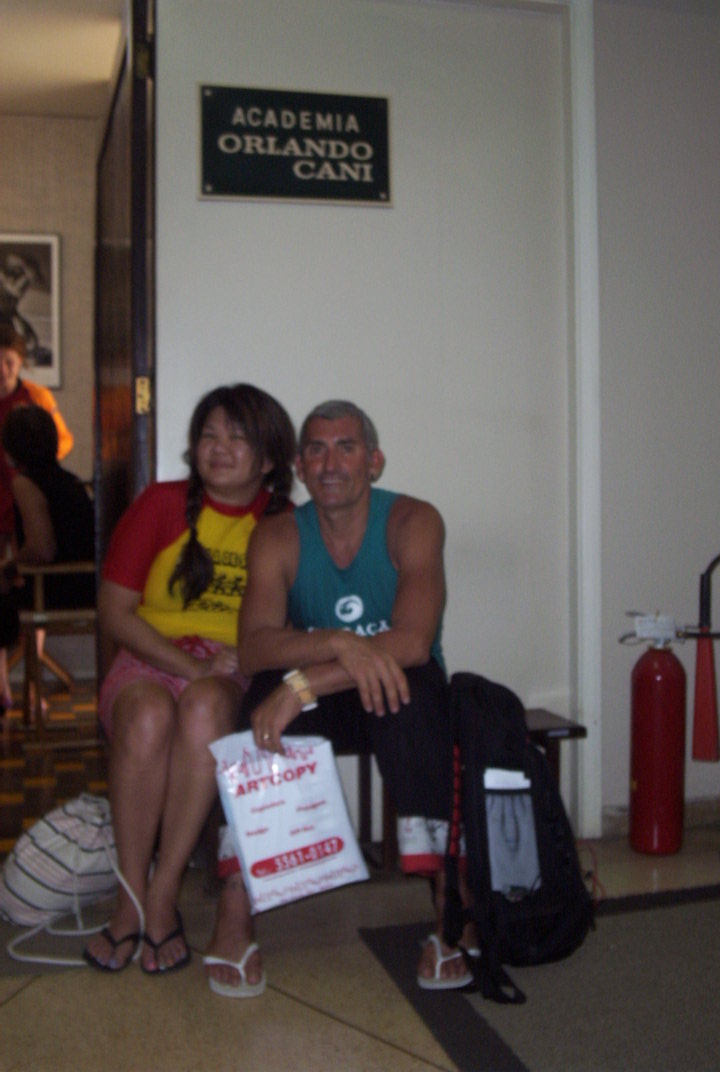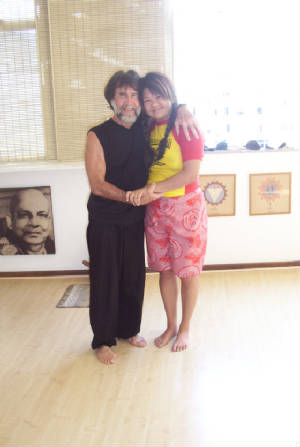|
|
 |
|

|
 |
|
Yoga and Indoor cycling
Rare
is the yoga class where you put on a sweatshirt before going through Sun Salutations, but I clearly wasn't in any regular
yoga class as I piled on a fleecy layer to absorb some sweat before Down Dog. My quads were already shaky, my headband soaked,
and my throat begged for another gulp of water,and we hadn't even hit our mats yet.
Despite my healthy glisten (and
inner exhaustion), I pulled off my shoes and sweaty socks, shook out my legs, and stood in Tadasana (Mountain Pose), ready
to begin the second half of a Yoga Journey class. Also known as Yoga and indoor cycling, this new trend of classes combines
yoga and indoor cycling, an Ironman-worthy workout in which students pedal through an instructor-led, visualized ride on stationary
bikes.
A few years ago, Noll Daniel, a Indoor cycling teacher and yogi, taught Indoor cycling and yoga classes back-to-back
in a New York City gym. Some of his students would double up: sweat through a 45-minute Indoor cyling class, then towel off
and strike poses for another hour. "The asanas seemed easier since we were already warmed up," says Daniel, who has been teaching
yoga for 15 years and Indoor cyling for four. He suggested a combination class to the manager at Chelsea Piers, the New York
City club where he teaches, and Yoga Journey was born.
Putting the Pedal to the Mental
Although each instructor
usually a yogi with an interest in aerobic activity, individualizes the class format, the basic structure of the classes remains
consistent. A combination of stretching, breathing, and cardio work, the warm-up can be done either on the bike or the mat.
Helen McGee, a private instructor in Napa Valley, California, favors beginning with the full Sun Salutation series, then moving
on to some more challenging poses like Virabhadrasana I (Warrior I) and Balancing Prayer Twist, a variation of Utkatasana
(Chair). "When you get off the bike, your legs are usually pretty wobbly," says McGee, "so I like to do the challenging stuff
first."
After students generate some warmth, the ride begins. Usually set to New Age music or sounds from the Caribbean
and Africa, the journey involves a series of hills, flats, and sprints, created on the bike by increasing or lowering the
front wheel's resistance and in the mind by visualizing the road ahead of you. Again, the instructor's personal preference
determines whether you climb Mount Everest or sprint for the Tour de France finish line. McGee prefers to focus on developing
endurance and strength, while Daniel led us through some challenging interval work. After about 30 to 40 minutes of Indoor
cyling, students dismount, stretch, do a few more asanas. Daniel had us use the bike's handlebar for balance during modified
versions of Utthita Hasta Padangusthasana (Extended Hand-to-Big-Toe Pose) and Natarajasana (Lord of the Dance Pose) throw
on the aforementioned sweatshirt, take off their shoes, and roll out the mats. About 40 minutes of different asanas follow;
most, like Uttanasana (Standing Forward Bend) and Eka Pada Rajakapotasana (One-Legged King Pigeon Pose), focus on stretching
hip flexors, quads, calves, and other cycling-specific muscles while simultaneously slowing down the heart.
If you
haven't thought about Indoor cyling before, perhaps you should. More important than the tabulated sweat factor are the cardio
benefits Indoor cyling brings to a yogi's regimen. "I have greater awareness about the capabilities of my body," says Daniel.
"Plus, I'm stronger, have more energy, and just feel good." Most Indoor cyling classes last 45 minutes, but because of the
workout's intensity, cyclists get their heart rates soaring within minutes; a 130-pound woman can burn about 500 calories
during that time.
At first glance, yoga and Indoor cyling appear to go together like Oprah and Howard Stern, but they
actually complement each other. "They're a perfect yin and yang," says McGee. "They both allow you to go inside of yourself
in an interesting way." They're also the ultimate balanced workout in that muscles get strengthened and stretched, your mind
goes on a calming inner journey, and your heart gets a fierce pumping.
Physically, many of the tenets of indoor cycling
mirror those of yoga. Staying centered and grounded is paramount, whether you're on the bike or the mat. Just as most asanas
from Trikonasana (Triangle Pose) to Sirsasana (Headstand)require energy and movement radiating from your core, Indoor cyling
at high revolutions with little resistance requires a solid sense of balance, beginning from your lower back and abs. (Throughout
our workout, Daniel reminded us to lift up from the abdominals and to keep them engaged for maximum support.)
Similarly,
both require a solid sense of body position and knowledge: For the most efficient cycling, you need to know how to engage
and feel each muscle in your leg, just as you need to know how to "spiral" out your thighs in Adho Mukha Svanasana (Downward-Facing
Dog). The energy level in both classes is similar too in that they begin low and then build to an outburst.
Perhaps
the most important physical trait Indoor cyling and yoga share is the use of the breath. Sunny Davis, a North Carolina-based
instructor who holds Yoga Indoor cyling clinics for instructors around the country, realizes that Western athletes may not
be as accepting of nontangible concepts like "proper breathing eases effort," so she has her students wear heart rate monitors
while Indoor cyling. She introduces them to the power of pranayama through a simple exercise of counting how many cycles of
breath (inhalation and exhalation) they observe per minute. Not surprisingly, when they breathe correctly their heart rates
go down despite the fact that the workload may go up.
"Somebody came up to me after a class and told me she took the
class knowing she was going to hate it," Davis says, "but then she saw the numbers on her monitor go down and realized what
a powerful tool correct breathing could be. That drove it home for her."
The personal focus inherent in concentrating
on the breath is representative of the inward attention required by both practices. When you practice yoga in a class, the
teacher suggests a pose and you listen to your tight muscles, aching joints, and flexible tendons to realize how far you'll
be able to take it. In Indoor cyling, the instructor tells you where you're going and how hard to go, but the image you see
is ultimately drawn from within and you work at a comfortable pace for your body.
During the course of Yoga Journey,
I was able to go inside myself more deeply than I've been able to during a solitary bike ride or a single yoga class. I've
never experienced so intensely the feeling of pushing my heart to its limit, then consciously slowing it down.
Perhaps
that's the draw of both disciplines: The inner experience is always unique and revelatory. "In yoga the asanas don't change,
yet each time you practice, you have a different experience with them," says McGee. "It's the same thing in Indoor cyling:
A flat ride is always a flat ride, but you never have the same ride twice."

|
 |
|
|
 |
|
|
 |
|
|
|
|


When Yoga Hurts...
Donna Kay Lau completed her Yoga teacher Training, Yoga as Therapy training, and is a Yoga enthusiast.
Amy
Toosley was standing in a split pose when her yoga instructor gave her leg a little prod. "I heard the loudest pop I've ever
heard, and the instructor said, 'Ooh! Good release, huh?'" Toosley recalls. "Not really--I could hardly walk." With her hamstring
muscle snapped, Toosley, 32, avoided yoga for the next three months, and almost a year later, she is still in pain.
Bad-mouthing
yoga seems like begging for a hit of unfavorable karma. But with more than 14 million people practicing yoga or tai chi nationwide,
up 136% since 2000, orthopedic surgeons, physical therapists and chiropractors across the country are dealing with the increasing
fallout from yoga gone awry. Over the past three years, 13,000 Americans were treated in an emergency room or a doctor's office
for yoga-related injuries, according to the Consumer Product Safety Commission.
Often people get hurt because they
assume that yoga is simple and that anybody can pretzel himself or herself on demand. Edward Toriello, an orthopedic surgeon
and spokesman for the American Academy of Orthopaedic Surgeons, says most of the injuries he sees are sustained by "weekend
warrior" baby boomers who begin yoga without realizing that their bodies are no longer what they used to be. "They think that
yoga is an easy way to start exercising, so they go to class once a week, not stretched out at all, and they get hurt."
At
the same time, others see yoga--a practice originally conceived to help people achieve inner peace and tranquillity--as a
way to get a vigorous workout. More than five times as many people take yoga classes at health clubs today as did a decade
ago, and enthusiasts have devised all kinds of variations appalling to purists: hip-hop yoga, disco yoga, power yoga, not
to mention controversial hot yoga, or Bikram, which incites people to push themselves to their limit in sweltering rooms in
which temperatures are set at 105ºF (41ºC).
The truth is, yoga, regardless of the form, doesn't offer a comprehensive
way to get fit. According to a study by the American Council on Exercise, a national nonprofit organization that certifies
fitness instructors and promotes physical fitness, dedicated yoga practitioners show no improvement in cardiovascular health.
It's not the best way to lose weight either. A typical 50-min. class of hatha yoga, one of the most popular styles of yoga
in the U.S., burns off fewer calories than are in three Oreos--about the same as a slow, 50-min. walk. Even power yoga burns
fewer calories than a comparable session of calisthenics. And while yoga has been shown to alleviate stress and osteoarthritis,
it doesn't develop the muscle-bearing strength needed to help with osteoporosis.
Part of the problem is that increasingly,
the people teaching yoga don't know enough about it. Yoga was traditionally taught one-on-one by a yogi over a period of years,
but today instructors can lead a class after just a weekend course. Though the Yoga Alliance, formed in 1999 and now based
in Clinton, Md., has set a minimum standard of 200 hours of training for certification, only 16,168 of the estimated 70,000
instructors in the U.S. have been certified. "Yoga means bringing together mind, body and spirit, but in Western yoga, we've
distilled it down to body," "That's not even yoga anymore. If the goal is to look like Madonna, you're better off running
or indoor cycling." Namaste to that.

*No affiliations with Mad Dogg Athletics Inc, and Spinning, Spin or 24 Hour Fitness.
This is Donna Lau's Private and Personal website
|
|
|
 |

